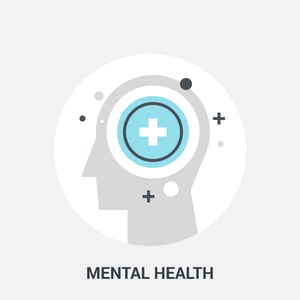Supporting Mental Health in the Workplace

Work-related stress, ranging from pressure of our always-connected culture to burnout, impacts absenteeism and performance. So, too, does non-work-related stress, like personal and financial worries, health challenges, and even the current political climate, says HR Executive. Anxiety and depression diagnoses are up by double digit percentages, per another article in HR Executive. Additionally, the link between mental health and physical health is clear. Anxiety and depression are risk factors for health concerns like heart disease and stroke. With more than three in four employees saying they’ve struggled with a mental health challenge, this is not an issue concerning only a small minority of employees.
For many, fear about discrimination from peers, managers, or leadership, the stigma surrounding mental health in general, as well as specific concerns about job protection make sharing a diagnosis or seeking help unappealing. This is an organizational challenge and requires an organizational response. Since culture starts at the top, this must include an accessible plan visibly championed by leadership, who help create a workplace culture that supports mental health, offers comprehensive programs and benefits, recommends resources engages employees at all level in decision-making and more.
HR departments need to promote and share the services that are available via health insurance plans or employee assistance programs. Additionally, HR teams, or perhaps all employees, need training on how to recognize symptoms of a mental health challenge and respond by offering resources. Even simple steps like encouraging mindfulness about language or jokes that call out mental health can also help create a climate that encourages openness and support.
As we learn more about the spectrum of mental health, and how often and fluidly individuals move between fully functional and a crisis, the more important empathic, proactive support will be. Many companies have worked to bolster mental health offerings and de-stigmatize seeking help when a crisis strikes. The next step, according to HR experts, is to offer preventative or proactive resources to help employees build resiliency and learn stress management techniques, says Harvard Business Review.
Beyond traditional components like talk therapy and medical interventions as part of health plans or employee-assistance programs, many companies are turning to tech resources, like apps for meditation or tools that gamify or encourage exercise and sleep as well as content on demand, like webinars on parenting, stress reduction, and other relevant topics.
Higher employee assistance plan utilization leads to lower short-term and long-term-disability claims, according to HR Executive. Leaders concerned about employees seeking treatment and taking time away from work can look to data like this that shows returns on an investment in employee mental health. Beyond being the right thing to do for employees, it’s often the right thing to do for the bottom line.
Read more:
7 Ways to (Effectively) Address Mental Health in the Workplace
5 Ways Bosses Can Reduce the Stigma of Mental Health at Work

